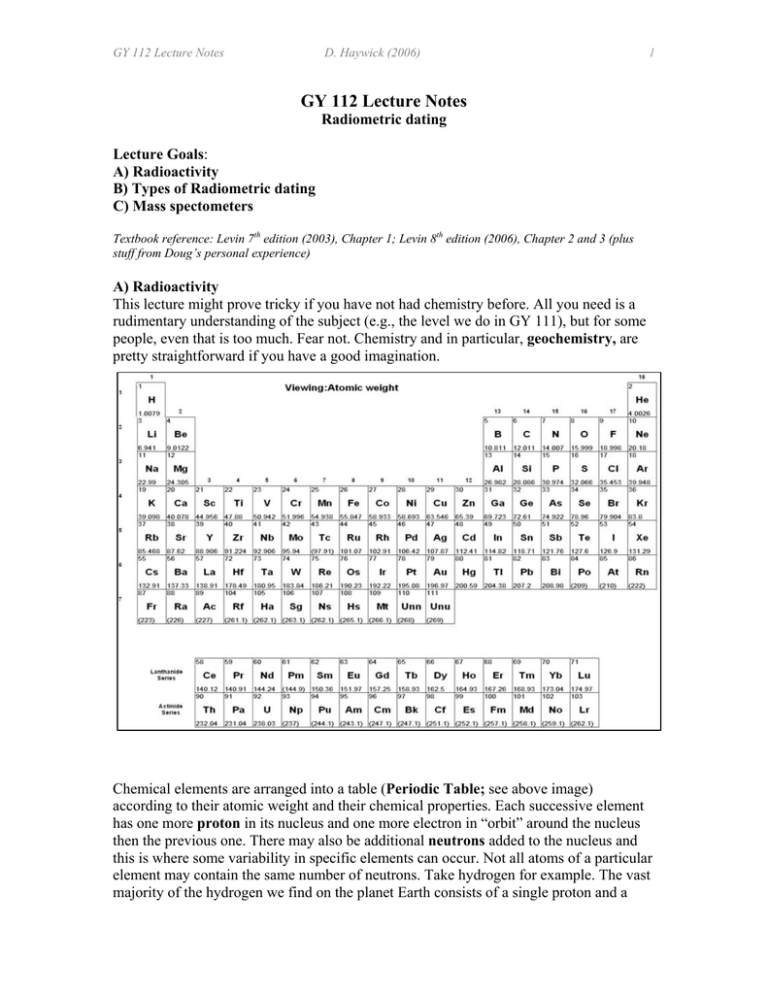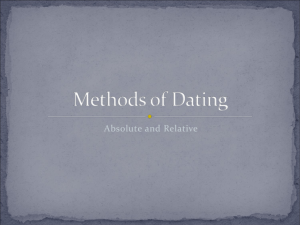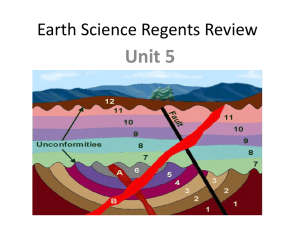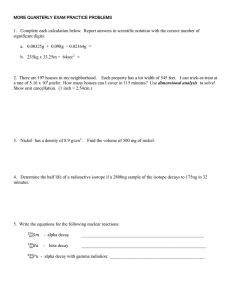GY 112 Lecture Notes Radiometric dating Lecture Goals
advertisement

GY 112 Lecture Notes D. Haywick (2006) 1 GY 112 Lecture Notes Radiometric dating Lecture Goals: A) Radioactivity B) Types of Radiometric dating C) Mass spectometers Textbook reference: Levin 7th edition (2003), Chapter 1; Levin 8th edition (2006), Chapter 2 and 3 (plus stuff from Doug’s personal experience) A) Radioactivity This lecture might prove tricky if you have not had chemistry before. All you need is a rudimentary understanding of the subject (e.g., the level we do in GY 111), but for some people, even that is too much. Fear not. Chemistry and in particular, geochemistry, are pretty straightforward if you have a good imagination. Chemical elements are arranged into a table (Periodic Table; see above image) according to their atomic weight and their chemical properties. Each successive element has one more proton in its nucleus and one more electron in “orbit” around the nucleus then the previous one. There may also be additional neutrons added to the nucleus and this is where some variability in specific elements can occur. Not all atoms of a particular element may contain the same number of neutrons. Take hydrogen for example. The vast majority of the hydrogen we find on the planet Earth consists of a single proton and a GY 112 Lecture Notes D. Haywick (2006) 2 single electron. (1H). But some atoms of hydrogen have a nucleus that contains 1 proton and 1 neutron (see image to left from http://www.emc.maricopa.edu /faculty/farabee/ BIOBK/BioBookCHEM1.html). This atom retains the same charge (neutrons are neutral), but since neutrons weigh about the same as a proton, the weight of this “heavy” hydrogen is doubled (2H). Atoms with the same number of protons but different numbers of neutrons are called isotopes. Isotopes are generally identified through their atomic number, but in the case of hydrogen, the isotopes are actually named (almost like they were distinct elements). 2H is commonly called deuterium and is given the chemical symbols D. Heavy water, which is used as a neutron absorber in nuclear power plants is D2O. A third isotope of hydrogen is also known. Its nucleus consists of 1 proton and 2 neutrons (3H). This isotope is called tritium (T) and is different from the other two in being unstable. The nucleus of tritium is too heavy and gradually breaks apart. The decay is one of the forms of radioactivity and which in this case, and several other elements as well, is hazardous to life forms. Some unstable elements are, however, useful for geological interpretations of time. Using radioactive decay to establish geological time is called radiometric (or radioisotopic) dating. Before we discuss dating, it is necessary to first discuss how radioactivity occurs and how we can use it to tell time There are 3 types of radioactive decay based upon the type of particle lost (or occasionally gained) by an unstable isotopes nucleus. They are α (alpha), β (beta) and γ (gamma). Radioactive decay changes elements into other elements. The original isotope is called the parent isotope. The element it decays into is called the daughter isotope. Let’s start with beta decay (which is easier to deal with than the others). A geologically important isotope that exhibits this decay behavior is 14C (carbon-14): 14 C → 14N + β The beta particle here is just an electron emitted at pretty high velocity from the nucleus of the 14C atom. But how do you get an electron from a nucleus and come to think of it, how do you get an additional proton? Moreover, how does carbon change into a nitrogen atom which has one more proton in the nucleus than a carbon atom). All of these changes can be explained through the following nuclear reaction; a neutron in the parent isotope spits into a proton (which stays in the nucleus) and an electron (which is expelled from the nucleus). That is the basic mechanism for beta decay, and it is illustrated on the top of the next page first in cartoon fashion, then in glorious Technicolor. The nice images in this section all come from the following source: http://wps.prenhall.com/wps/media/objects/476/488316/ch17.html GY 112 Lecture Notes D. Haywick (2006) Alpha decay occurs through a more complex process (see image at bottom right). An example of a geologically important isotope displaying this form of decay is 238U (uranium-238): 238 U → 206Pb + 8α An alpha particle is essentially a Helium nucleus (4He). The alteration of 238U to 206Pb is complex and involves numerous intermittent daughter isotopes: 238 222 U→ 234Th →234Pa →234U→ 230Th →226Ra→ Rn→ 218Po→ 214Pb →214Bi→ →210Tl/214Po→ 210 Pb →210Bi →210Po→ 206Pb (stable) A second geologically important isotope of uranium is 235U (uranium 235). It decays to 207Pb (lead-207) 3 GY 112 Lecture Notes D. Haywick (2006) 4 through the following: 235 U → 207Pb + 7α Gamma decay is emission of radiation (very short wavelength) associated with capture of an electron. The radiation has no mass, and so its emission does not change the element; however, gamma radiation often accompanies alpha and beta emission, which do change the element's identity. The decay of 40K (potassium-40) is an example of gamma-decay: 40 K + e → 40Ar + e The decay of 40K is like the inverse of beta decay. The electron is absorbed into the 40K nucleus where it combines with a proton to form a neutron. The mass stays the same, but the loss of a proton changes the isotope into argon. Only about 11% of 40K decays to 40 Ar. The remaining 89% alters to 40Ca through beta-decay. B) Types of radiometric dating We can use radioactive decay to date rocks for one very important reason; the rate of radioactive decay is absolutely constant for any given isotope under any situation. Carbon-14 will decay to 14N at the same rate no matter what you do to a substance that contains it. You can freeze it, bake it melt it, vaporize it and the 14C it contains will still decay at the same rate. Geologists visually decay rates through the concept of isotopic half life. The half life is the amount of time necessary for ½ of the parent isotope to decay to its daughter. For 14C, the half life (t1/2) is 5,730 years. The decay is logarithmic rather than linear. If you start off with 1 gram of 14C, then after 1 t1/2, 0.5 grams will remain. After 11,460 years (2 t1/2), 0.25 grams of 14C will remain. After 17,190 years (3 t1/2), 0.125 grams remains. After 22,920 years (4 t1/2), 0.063 grams will remain etc. The geological age of a material is primarily determined on the basis of the ratio of parent isotope to daughter isotope. For example, if you determine that the substance you are examining has 50% of its original 14C remaining (half of it is gone), then 1 λ1/2 has passed since it was formed and it must be 5,730 years old. All radioactive elements decay through this logarithmic manner. The difference is in the length of time of the half life (see table 1). Incidentally, you never really get to 0 through logarithmic decay, but after a certain number of half lives (usually 10), so little parent isotope remains that you can’t really get an accurate age. Carbon-14 dating has easily date material to about 57,000 years (10 t1/2), but to extend it further back (100,000 years is possible for 14C), requires expensive techniques. GY 112 Lecture Notes D. Haywick (2006) 5 Figure 1: Radioactive decay of parent atoms and subsequent increase of daughter atoms compared to isotope half life. From Brice, J.C. et al., 1993. Laboratory Studies in Earth History. Wm. C. Brown, 242 pp. Table 1: Table radioactive isotopes of use for radiometric dating, their daughter products, approximate half lives and applications. Parent Isotope Daughter Isotope Half Life Datable Material(s) (years) 14 14 5,730 Wood, shells and organic C (Carbon-14) N (Nitrogen-14) 235 40 U (Uranium-235) K (Potassium-40) 207 40 Pb (Lead-207) Ar (Argon-40) 700,000,000 1,300,000,000 238 U (Uranium-238) 206 Pb (Lead-206) 4,500,000,000 232 Th (Thorium-232) 208 Pb (Lead-208) 14,000,000,000 Sr (Strontium-87) 48,600,000,000 87 Rb (Rubidium-87) 147 Sm (Samarium-147) 87 143 Nd (Neodymium-143) 106,000,000,000 material Metamorphic, igneous rocks, Zircon, U-bearing minerals Metamorphic, igneous & sedimentary rocks; feldsparbearing minerals Metamorphic, igneous rocks, Zircon, U-bearing minerals Metamorphic, igneous rocks, Zircon, U-bearing minerals Various rocks and minerals Very old rocks, REE bearing minerals Not every geological material can be dated absolutely. The reason is pretty simple; not all minerals or substances contain radioactive isotopes. In fact, it is more accurate to state that most geological materials cannot be absolutely dated because they do not contain radioactive substances. Which materials are good for dating? Those that contain uranium, thorium, REE’s (rare earth elements) and potassium. Table 1 summarizes some of the rocks and minerals that can be easily radiometrically. As you will see, with the exception of 14C (organic material), most of the materials that can be dated are crystalline (i.e., igneous or metamorphic). The best way to date stratigraphic (sedimentary) units using GY 112 Lecture Notes D. Haywick (2006) 6 absolute methods is to find a bedded rock that is high in dateable minerals (e.g., volcanic ash bed, intrusive dikes and sills etc.) C) Mass spectrometry So how do you radiometrically date a rock? You need to use the following relationship known as the age equation: N=Noe-λt where No is the number of atoms of parent isotope remaining in a substance, N is the number of atoms of daughter isotope produced through decay, λ is the decay constant (which depend on the isotope in question) and t is the amount of elapsed time. It isn’t all that difficult to count atoms. All you need is a device that is capable of separating them and detecting how many of each there are. The device is called a mass spectrometer (see image of the isotope mass spec. from the University of London, Queen Mary College; http://www.biology.qmul.ac.uk/srif/Environmental_under_construction.html). Samples to be analyzed are first vaporized and then passed through a powerful magnetic field. The field separates atoms of different weight (remember isotopes have different weights) before they get to the detectors. If you know the half life of the isotope, you can easily determine the age of the material you were studying. You will get a chance to do this in an upcoming lab. Important terms/concepts from today’s lecture (Google any terms that you are not familiar with) Radiometric dating Geochemistry Periodic table of the elements Radioisotopes Isotopes Protons Neutrons Radioactivity Parent isotope Daughter isotope Alpha decay Beta decay Gamma decay Half life Age equation Mass spectrometer






